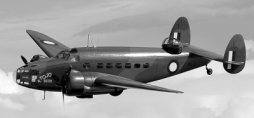
Lockheed Hudson
One of the few combat aircraft to have been developed from a civil transport, the Lockheed Hudson maritime patrol bomber (and navigator trainer) owes its basic design to the Lockheed Model 14 Super Electra of the late 1930s. The Hudson was a smooth handling and popular aircraft which never quite had the performance needed in warfare. Nevertheless, it made a fine contribution to the Allies' war effort.
Based on the Super Electra civil transport, the Hudson was the first American-built aircraft to fly with Royal Air Force during World War II. The airframe was instantly recognisable as a modified Electra, with more powerful engines, gun armament and internal bomb-bay. This bomber was rushed into production to meet Britain's requirement for a maritime patrol aircraft and navigation trainer. Search and rescue Hudsons were also built, with a lifeboat stored under the fuselage.
After its early success in British use, the Hudson was employed by the US Army Air Forces in A-28 and A-29 attack variants and as the AT-18 advanced trainer. The US Navy adopted the Hudson as a patrol bomber and called it the PBO.
US Navy Hudsons sank two U-boats on 15 March 1942. This was the first of several such successes in combat. An A-29 sank the German submarine U-701 on 7 July 1942.
Hudsons were used by many Allied air forces, including the Soviet Union and South Africa. The aircraft continued to serve faithfully in support roles up unitl the end of the war.
 |
 |
 |
| Hudsons also saved lives. This aircraft from No. 123 Squadron, Royal Canadian Air Force, carried a large lifeboat under the fuselage, which could be dropped to survivors at the scene of a disaster. |
This ammaculate Hudson with the pre-1942 American markings and British camouflage was one of the first A-29s repossessed by America. |
This highly polished Hudson is an AT-18 gunnery trainer. These aircraft allowed trainee gunners to fire shots realistically from the turrets in peacetime conditions. |
|
Lockheed Hudson (Technical Specification) |
| Role |
Maritme patrol-bomber |
| Manufacturer |
Lockheed |
| Maximum Speed |
396 kmh (245 mph) |
| Maximum Range |
3,154 km (1,955 miles) |
| Ceiling |
7,620 meters (25,000 feet) |
Weight
Empty
Maximum Takeoff |
5,275 kg (11,605 lbs)
7,938 kg (17,464 lbs) |
Dimensions
Wingspan
Length
Height
Wing Area |
19.96 meters (65 ft)
13.51 meters (44 ft)
3.61 meters (12 ft)
51.19 square meters (551 sq ft) |
| Engines |
Two Wright GR-1820-G-102A radial piston engines each providing 820-kW (1,100 hp) |
| Armament |
Two 7.62 mm (0.30 cal) forward firing machine-guns
Two similar weapons in a dorsal turret
plus up to 635 kg (1,400 lbs) of bombs or depth charges in internal bomb-bay |
Photo Gallery
Click here to submit your photo
| Have A Passion For Aircraft? |
Subscribe to our 14 series FREE newsletter
delivered weekly on World War 2 Aircraft factfile... |
| NB:- We hate spam as much as you do, so your email address will NEVER be shared with or sold to anyone else. That's a Guarantee. |
|
|





